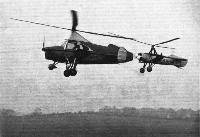
Варианты
- De Havilland - Puss Moth / D.H.80 - 1929 - Великобритания
- Cierva/De Havilland - C.24 - 1931 - Великобритания
- De Havilland - Leopard Moth / D.H.85 - 1933 - Великобритания
Cierva (автожиры X. Сиервы)
<...>
Автожир С.24 с двухместной кабиной был разработан и построен фирмой "de Havilland Aircraft Со.", несущий винт для него изготовила фирма Сиервы. Единственный экземпляр с мотором de Havilland Gipsy III мощностью 120 л. с. (90 кВт) с трехлопастным винтом был впервые облетан Сиервой в сентябре 1931 года. Впоследствии он получил двухлопастный винт и в этой конфигурации под названием С.26 совершил в 1932 году тур по Европе. Позднее его сохранили в качестве музейного экспоната.
Один из самых маленьких автожиров - одноместный промежуточный аппарат С.25 - был построен фирмой "Comper Aircraft" и облетан в начале 1933 года. Фюзеляж, по-видимому, сделали на базе авиетки Comper Swift с модифицированным хвостовым оперением и низко расположенным крылом малого размаха. Аппарат имел звездообразный мотор Pobjoy Niagara R мощностью 85 л. с. (63 кВт). Несмотря на высокие характеристики, заказов на него не последовало.
В 1932 французская фирма "Liore-et-Olivier" приобрела лицензию Сиервы. На основе детального изучения конструкции С.19 Mk IV она построила аппарат С.27 с фирменным обозначением CL.10 в честь Сиервы и французского разработчика Жоржа Лепере. С.27 был автожиром с двухместной кабиной без крыла, мотором Pobjoy мощностью 75 л. с. (60 кВт) и трехлопастным винтом. Он разбился в Орли, совершив всего несколько полетов.
Далее, согласно нумерации, хотя и не по хронологии идет автожир CL.20 с двухместной кабиной, разработанный Лепере и построенный фирмой "Westland". 5 февраля 1935 года он взлетел в Хэнуорте с закапотированным мотором Niagara III мощностью 90 л. с. (67 кВт). Фирма "Westland" не занималась его доработкой, но интересно заметить, что в 1937 году Питкэйрн в США предложил построить версию, известную как АС.35 с мотором Pobjoy мощностью 110 л. с. (82 кВт), в то время как в 1956 году Лепере, как считают, работал над частной разработкой своего проекта 1934 года для французской компании "Giravia Company". Обозначенный L.30, он должен был иметь трехместную кабину и мотор Continental 145 л. с. (108 кВт).
Компания "G. & J. Weir" в Глазго построила одноместный автожир, взлетевший в начале лета 1933 года и обозначенный W-1. Так как аппарат построили согласно лицензии Сиервы, ему присвоили номер С.28. Автожир имел мотор Douglas Dryad мощностью 40 л. с. (30 кВт) и двухлопастный винте механической раскруткой. Впоследствии фирма "Weir" строила другие автожиры, и ее достижения в этом деле были восприняты компанией "Cierva" в 1945 году.
В 1934 году попробовали реализовать идею автожира большого размера. Аппарат С.29 с пятиместной кабиной и незакапотированным звездообразным мотором Armstrong Siddeley Panther II мощностью 600 л. с. (447 кВт) разработала фирма "Westland". Сиерва поставил несущий винт и втулку. Конструкцию сделали из дюралевых труб. Из-за трагической гибели Хуана де ла Сиервы в авиакатастрофе (не на автожире) этот проект пришлось оставить.
<...>
Описание:
- Cierva (автожиры X. Сиервы)
- Flight, November 1932
British Aircraft
Фотографии
-
Aeroplane Monthly 1999-06 / J.Maynard - Spring-cleaning the hall /Mosquito aircraft museum/
Регистрационный номер: G-ABLM [18] The unique Cierva C.24 Autogiro, based on the forward fuselage of a D.H.80 Puss Moth.
-
Flight 1931-09 / Flight
Регистрационный номер: G-ABLM [18] A STRANGE-LOOKING BEAST: The De Havilland-built Autogiro has but three rotor blades. A wheel under the nose prevents overturning on the ground.
-
Flight 1931-09 / Flight
Регистрационный номер: G-ABLM [18] THE NEW AUTOGIRO: Front view of the latest type, built for the Cierva Autogiro Company by the De Havilland Aircraft Company. The engine is a "Gipsy III."
View of the unmarked C.24 taken at the end of August, 1931, in its original finless configuration. Note the minimal frontal area and the wide-track undercarriage. -
Aeroplane Monthly 1974-04 / News Spotlight
Регистрационный номер: G-ABLM [18] The unique Cierva C.24, G-ABLM, has been restored by Hawker Siddeley apprentices at Hatfield. It is hoped that the autogiro will be displayed at Salisbury Hall, Hatfield.
-
Aeroplane Monthly 1989-04 / R.Riding - Cierva C.24 autogiro /British prewar lightplanes/ (5)
Регистрационный номер: G-ABLM [18] Arthur Rawson about to demonstrate the C.24 at Hanworth on November 19, 1931. Note the revised tailplane and addition of front wheel spat.
-
Мировая Авиация 90
Регистрационный номер: G-ABLM [18] Единственный автожир С.24 восстановили для экспонирования в Музее самолетов "Mosquito" в Великобритании, где он стоял еще в конце 2009 года. Хорошо видна закрытая кабина машины.
-
Aeroplane Monthly 1989-04 / R.Riding - Cierva C.24 autogiro /British prewar lightplanes/ (5)
Регистрационный номер: G-ABLM [18] STARTING ON ITS FIRST LONG RACE: The "Autogiro" cabin machine, piloted by Mr. Brie, averaged 103.5 m.p.h. in the London-Newcastle race.
Two photographs of the C.24 taken at Brooklands on August 6, 1932, at the start of the London-Newcastle air race. Duckham's NP5 engine oil is being advertised on the rotor pylon. With Reginald Brie as pilot the C.24 came sixth in the race, averaging 103-5 m.p.h. -
Flight 1931-11 / Flight
Регистрационный номер: G-ABLM [18] "FORMATING": The two new Autogiros are here seen taking off at Stag Lane aerodrome, the C.24 piloted by Senor de la Cierva and the C.19 Mark IV by Captain Rawson.
Juan de la Cierva flying the C.24 in company with the prototype C.19 Mk IV G-AAHM at Stag Lane on November 12, 1931.Другие самолёты на фотографии: Cierva/Avro C.19 - Великобритания - 1929
-
Aeroplane Monthly 1989-04 / R.Riding - Cierva C.24 autogiro /British prewar lightplanes/ (5)
Регистрационный номер: G-ABLM [18] Attractive air-to-air photograph of the modified C.24, showing the shape of the original rotors, later changed for constant chord blades.
-
Flight 1932-05 / Flight
Регистрационный номер: G-ABLM [18] American interest in the cabin Autogiro at Hanworth: (Left to right) - Larsen, H. Pitcairn, A/M. J. G. Weir, Senor de la Cierva, T. Ray, R. A. C. Brie.
-
Flight 1931-11 / Flight
Регистрационный номер: G-ABLM [18] FOREIGN INTEREST IN THE AUTOGIRO: A small French mission recently visited England to study the Cierva machines. Here some of its members are seen with representatives of the Cierva company. From left to right: P. Cour, G. Prat, L. Bourdin, J. de la Cierva, G. Lepere, and A. H. Rawson.
-
Flight 1932-08 / Flight
Регистрационный номер: G-ABLM [18] DISTINGUISHED VISITORS TO A.S.T.: On July 28 three "Autogiros" flew from Hanworth to Hamble, carrying three distinguished Italian visitors, who are seen in this group, which includes, from left to right, Mr. Marsh (pilot), Senior de la Cierva, H.R.H. the Duke of Aosta, Commendatore Mameli, Italian Charge d'Affaires, Col. Bitossi, Italian Air Attache, and Mr. Brie, chief pilot.
-
Air Enthusiast 1994-12 / M.Lowe - Island Hopper
Регистрационный номер: G-ABLM [18] G-ABLI in varied company. Note the single porthole behind the pilot’s cabin - was this prior to the Karachi flight or afterwards? Recognisable among the aircraft in the photograph are Cierva C24 G-ABLM (withdrawn from use December 1934); Puss Moth; Dessoutter (either G-ABFO or G-ABRN); Hendy 302 G-AAVT; Junkers F.13ge G-ABDC (sold in Sweden December 1934) and Comper Swift G-ABPE. Can anyone name and date the occasion?
Другие самолёты на фотографии: Comper Swift / CLA.7 - Великобритания - 1930De Havilland Puss Moth / D.H.80 - Великобритания - 1929Hendy Hendy 302 - Великобритания - 1929Junkers F 13 - Германия - 1919Koolhoven FK-41 - Нидерланды - 1928Spartan Cruiser - Великобритания - 1932
-
Aeroplane Monthly 1989-04 / R.Riding - Cierva C.24 autogiro /British prewar lightplanes/ (5)
Регистрационный номер: G-ABLM [18] The rather shabby C.24, minus its engine, on display at the Fifty Years of Flying Exhibition at RAF Hendon on July 19, 1951.
-
Aeroplane Monthly 1989-04 / R.Riding - Cierva C.24 autogiro /British prewar lightplanes/ (5)
Регистрационный номер: G-ABLM [18] The C.24 during restoration at Hatfield. The fabric covering was retained and the autogiro was complete except for the rotor drive mechanism attachment to the Gipsy III engine.
-
Aeroplane Monthly 1989-04 / R.Riding - Cierva C.24 autogiro /British prewar lightplanes/ (5)
Регистрационный номер: G-ABLM [18] The restored C.24 after “roll-out” at Hatfield in February 1974.
-
Aeroplane Monthly 1983-07 / P.Capon - Capon's Corner
Регистрационный номер: G-ABLM [18] The de Havilland-built Cierva C.24 at Stag Lane on August 8, 1931 during construction. Juan de la Cierva made the first flight the following month. This aircraft still exists and is currently on display at the Mosquito Museum at Salisbury Hall.
-
Aeroplane Monthly 1989-04 / R.Riding - Cierva C.24 autogiro /British prewar lightplanes/ (5)
Регистрационный номер: G-ABLM [18] The C.24’s instrument panel after restoration at Hatfield in 1974. A notice advises the passenger not to leave the cabin while the rotors are in motion!
-
Aeroplane Monthly 1989-08 / Painted Wings
The Guild’s Press and Publicity Officer Charles Thompson has picked the Cierva C.24 Autogiro as the subject of this oil painting. He has entitled it Is it a bird? Is it a plane?
-
Flight 1931-11 / Flight
WILL IT COME TO THIS?: A FLIGHT Artist's conception of the result of combining three types which seek to avoid stalling and spinning; the Autogiro, the "Ente" and the Pterodactyl. The name might be something short and snappy, like "Pteroautogirentedactyl."
Другие самолёты на фотографии: Focke-Wulf F 19 Ente - Германия - 1927Westland-Hill Pterodactyl IV - Великобритания - 1931
- Фотографии



















